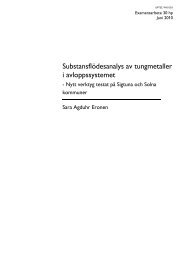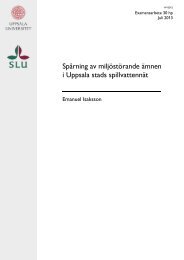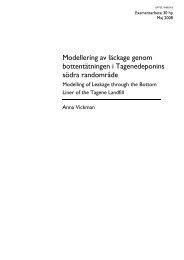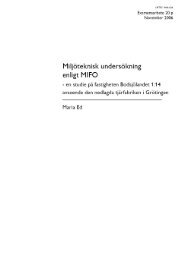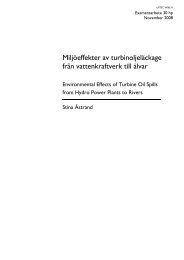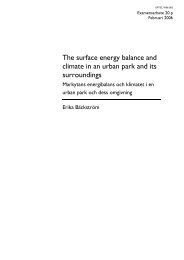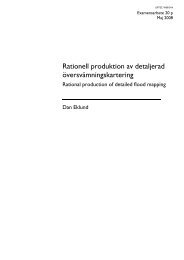Nutrient Transport Modelling in the Daugava River Basin - DiVA Portal
Nutrient Transport Modelling in the Daugava River Basin - DiVA Portal
Nutrient Transport Modelling in the Daugava River Basin - DiVA Portal
You also want an ePaper? Increase the reach of your titles
YUMPU automatically turns print PDFs into web optimized ePapers that Google loves.
Groundwater nutrient loadsThe groundwater nutrient load to <strong>the</strong> stream is obta<strong>in</strong>ed by multiply<strong>in</strong>g <strong>the</strong> flow fromeach groundwater box by <strong>the</strong> groundwater nutrient concentration. The monthlygroundwater nutrient load is thus calculated as follows:dm∑DG = 0.1* AT(C1G1+ C2G2)(11)mgt=1tdm∑gt=1whereC1 g = nutrient concentration <strong>in</strong> groundwater box 1 [mg/l]C2 g = nutrient concentration <strong>in</strong> groundwater box 2 [mg/l]AT = watershed area [ha]3.3 AVAILABLE OBSERVATION DATA USED IN THE STUDYg3.3.1 Climate dataClimate data (daily precipitation and mean air temperature) for <strong>the</strong> years 1980 to 2000were taken from <strong>the</strong> BALTEX Hydrological Data Centre data base adm<strong>in</strong>istrated bySMHI. The value of daily temperature and precipitation is a spatial and temporal meanof several measur<strong>in</strong>g po<strong>in</strong>ts <strong>in</strong> <strong>the</strong> bas<strong>in</strong> and several times of measurement dur<strong>in</strong>g <strong>the</strong>day (Danielsson, 2005).3.3.2 Streamflow and nutrient load dataThe reported data consist of monthly means of streamflow, total nitrogen load and totalphosphorus load from 19702000 (Wulff and Rahm, 1990; Stålnacke 1996) with somedata gaps dur<strong>in</strong>g <strong>the</strong> 90’s. In figure 5 <strong>the</strong> reported streamflow and <strong>the</strong> reported loads ofnitrogen and phosphorus from <strong>the</strong> <strong>Daugava</strong> are displayed. Data from 19701990 werecompiled by Stålnacke (1996) with help from data obta<strong>in</strong>ed from <strong>the</strong> LatvianHydrometeorological Agency <strong>in</strong> Riga. Gaps <strong>in</strong> <strong>the</strong> data series were filled <strong>in</strong> by <strong>the</strong> useof statistical <strong>in</strong>terpolation and extrapolation methods. Different sampl<strong>in</strong>g sites wereused and it is not clear where <strong>the</strong> sampl<strong>in</strong>g sites are located, but <strong>the</strong>y are probablysituated a considerable distance from <strong>the</strong> mouth of <strong>the</strong> river. S<strong>in</strong>ce <strong>the</strong> areas of differentland uses <strong>in</strong> <strong>the</strong> bas<strong>in</strong> have been calculated from <strong>the</strong> mouth of <strong>the</strong> river this means that<strong>the</strong> dra<strong>in</strong>age area used as model <strong>in</strong>put is overestimated with respect to <strong>the</strong> dra<strong>in</strong>age areaof <strong>the</strong> sample stations. Also, <strong>the</strong> impact of Riga is not <strong>in</strong>cluded <strong>in</strong> reported data, s<strong>in</strong>ceRiga is situated at <strong>the</strong> mouth of <strong>the</strong> <strong>Daugava</strong>. Consider<strong>in</strong>g <strong>the</strong> data from <strong>the</strong> 90’s, <strong>the</strong>reis little <strong>in</strong>formation on how <strong>the</strong> data series were compiled and where <strong>the</strong> sample stationis located.12



